Black And Decker PHS550B Handleiding
Black And Decker
Zaagmachine
PHS550B
Bekijk gratis de handleiding van Black And Decker PHS550B (6 pagina’s), behorend tot de categorie Zaagmachine. Deze gids werd als nuttig beoordeeld door 29 mensen en kreeg gemiddeld 4.7 sterren uit 15 reviews. Heb je een vraag over Black And Decker PHS550B of wil je andere gebruikers van dit product iets vragen? Stel een vraag
Pagina 1/6

d) Remove any adjusting key or wrench before turning the power tool on. A wrench
or a key left attached to a rotating part of the power tool may result in personal injury.
e) Do not overreach. Keep proper footing and balance at all times. This enables bet-
ter control of the power tool in unexpected situations.
f) Dress properly. Do not wear loose clothing or jewelry. Keep your hair, clothing
and gloves away from moving parts. Loose clothes, jewelry or long hair can be
caught in moving parts.
g) - If devices are provided for the connection of dust extraction and collection facil
ities, ensure these are connected and properly used. Use of dust collection can
reduce dust-related hazards.
4) POWER TOOL USE AND CARE
a) Do not force the power tool. Use the correct power tool for your application. The cor-
rect power tool will do the job better and safer at the rate for which it was designed.
b) Do not use the power tool if the switch does not turn it on and off. Any power tool
that cannot be controlled with the switch is dangerous and must be repaired.
c) Disconnect the plug from the power source and/or the battery pack from the
power tool before making any adjustments, changing accessories, or storing
power tools. Such preventive safety measures reduce the risk of starting the power
tool accidentally.
d) Store idle power tools out of the reach of children and do not allow persons
unfamiliar with the power tool or these instructions to operate the power tool.
Power tools are dangerous in the hands of untrained users.
e) - Maintain power tools. Check for misalignment or binding of moving parts, break
age of parts and any other condition that may affect the power tool’s operation.
If damaged, have the power tool repaired before use. Many accidents are caused
by poorly maintained power tools.
f) Keep cutting tools sharp and clean. Properly maintained cutting tools with sharp cut-
ting edges are less likely to bind and are easier to control.
g) Use the power tool, accessories and tool bits, etc. in accordance with these
instructions, taking into account the working conditions and the work to be per-
formed. Use of the power tool for operations different from those intended could result
in a hazardous situation.
5) SERVICE
a) Have your power tool serviced by a qualied repair person using only identical
replacement parts. This will ensure that the safety of the power tool is maintained.
SPECIFIC SAFETY RULES
• Hold power tool by insulated gripping surfaces, when performing an operation where
the cutting accessory may contact hidden wiring or its own cord. Cutting accessory
contacting a “live” wire may make exposed metal parts of the power tool “live” and could
give the operator an electric shock.
• Use clamps or another practical way to secure and support the work piece to a stable
platform. Holding the work by hand or against your body leaves it unstable and may lead to
loss of control.
•Keep hands away from cutting area. Never reach underneath the material for any reason. Hold
front of saw by grasping the contoured gripping area. Do not insert fingers or thumb into the
vicinity of the reciprocating blade and blade clamp. Do not stabilize the saw by gripping the shoe.
• Keep blades sharp. Dull blades may cause the saw to swerve or stall under pressure.
• Use extra caution when cutting overhead and pay particular attention to overhead
wires which may be hidden from view. Anticipate the path of falling branches and debris
ahead of time.
• When cutting pipe or conduit ensure that they are free from water, electrical wiring, etc.
WARNING: Some dust created by power sanding, sawing, grinding, drilling, and
other construction activities contains chemicals known to the State of California to
cause cancer, birth defects or other reproductive harm. Some examples of these
chemicals are:
•leadfromlead-basedpaints,
•crystallinesilicafrombricksandcementandothermasonryproducts,and
•arsenicandchromiumfromchemically-treatedlumber.
Your risk from these exposures varies, depending on how often you do this type of
work. To reduce your exposure to these chemicals: work in a well ventilated area, and
work with approved safety equipment, such as those dust masks that are specially
designed to filter out microscopic particles.
• Avoid prolonged contact with dust from power sanding, sawing, grinding, drilling,
and other construction activities. Wear protective clothing and wash exposed areas
with soap and water. Allowing dust to get into your mouth, eyes, or lay on the skin may
promote absorption of harmful chemicals.
WARNING: Use of this tool can generate and/or disperse dust, which may cause
serious and permanent respiratory or other injury. Always use NIOSH/OSHA
approved respiratory protection appropriate for the dust exposure. Direct particles
away from face and body.
CAUTION: Wear appropriate hearing protection during use. Under some
conditions and duration of use, noise from this product may contribute to hearing loss.
WARNING: ALWAYS use safety glasses. Everyday eye glasses are NOT safety
glasses. Also use face or dust mask if cutting operation is dusty. ALWAYS WEAR
CERTIFIED SAFETY EQUIPMENT:
•ANSI Z87.1 eye protection (CAN/CSA Z94.3)
•ANSI S12.6 (S3.19) hearing protection
•NIOSH/OSHA/MSHA respiratory protection
Symbols
The label on your tool may include the following symbols.
V amperes
...........................
volts A
.........................
Hz watts
.........................
hertz W
........................
min minutes
........................ .......................alternating current
......................direct current n
o
.......................
no load speed
..........................Class II Construction ........................ earthing terminal
.........................safety alert symbol .../min revolutions or
..................
reciprocations per minute
FIRST AID MEASURES FOR GEL COMPONENTS (PHS550G ONLY)
If gel within the comfort grip becomes exposed and results in skin contact wash with soap
and water; for eye contact, flush with flowing water. If swallowed, seek medical attention.
Material Safety Data Sheet (MSDS) available from 1-800-544-6986
EXTENSION CORD
When using an extension cord, be sure to use one heavy enough to carry the current your
product will draw. An undersized cord will cause a drop in line voltage resulting in loss of
power and overheating. The table below shows the correct size to use depending on cord
length and nameplate ampere rating. If in doubt, use the next heavier gage. The smaller the
gage number, the heavier the cord.
CAT. NO. PHS550G/ PHS550B FORM NO. 90590171 AUG. ‘12
Copyright © 2012 Black & Decker PRINTED IN CHINA
VEA EL ESPANOL EN LA CONTRAPORTADA.
SAVE THIS MANUAL FOR FUTURE REFERENCE.
INSTRUCTIVO DE OPERACIÓN, CENTROS DE SERVICIO Y PÓLIZA DE GARANTÍA.
ADVERTENCIA: LÉASE ESTE INSTRUCTIVO ANTES DE USAR EL PRODUCTO.
INSTRUCTION MANUAL
General Safety Rules
WARNING: Read all safety warnings and all instructions. Failure
to follow the warnings and instructions may result in electric shock,
fire and/or serious injury.
SAVE ALL WARNINGS AND INSTRUCTIONS FOR FUTURE REFERENCE
The term “power tool” in the warnings refers to your mains-operated (cord-
ed) power tool or battery-operated (cordless) power tool.
1) WORK AREA SAFETY
a) Keep work area clean and well lit. Cluttered or dark areas invite accidents.
b) Do not operate power tools in explosive atmospheres, such as in the presence
of ammable liquids, gases or dust. Power tools create sparks which may ignite
the dust or fumes.
c) Keep children and bystanders away while operating a power tool. Distractions
can cause you to lose control.
2) ELECTRICAL SAFETY
a) Power tool plugs must match the outlet. Never modify the plug in any way. Do
not use any adapter plugs with earthed (grounded) power tools. Unmodified
plugs and matching outlets will reduce risk of electric shock.
b) Avoid body contact with earthed or grounded surfaces such as pipes, radiators,
ranges and refrigerators. There is an increased risk of electric shock if your body is
earthed or grounded.
c) Do not expose power tools to rain or wet conditions. Water entering a power tool
will increase the risk of electric shock.
d) Do not abuse the cord. Never use the cord for carrying, pulling or unplugging
the power tool. Keep cord away from heat, oil, sharp edges or moving parts.
Damaged or entangled cords increase the risk of electric shock.
e) When operating a power tool outdoors, use an extension cord suitable for outdoor
use. Use of a cord suitable for outdoor use reduces the risk of electric shock.
f) If operating a power tool in a damp location is unavoidable, use a ground fault
circuit interrupter (GFCI) protected supply. Use of a GFCI reduces the risk of elec-
tric shock.
3) PERSONAL SAFETY
a) Stay alert, watch what you are doing and use common sense when operating a
power tool. Do not use a power tool while you are tired or under the inuence
of drugs, alcohol or medication. A moment of inattention while operating power
tools may result in serious personal injury.
b) Use personal protective equipment. Always wear eye protection. Protective
equipment such as dust mask, nonskid safety shoes, hard hat, or hearing protection
used for appropriate conditions will reduce personal injuries.
c) Prevent unintentional starting. Ensure the switch is in the off position before
connecting to power source and/ or battery pack, picking up or carrying the
tool. Carrying power tools with your finger on the switch or energizing power tools
that have the switch on invites accidents.
Powered Hand Saw
CATALOG NUMBER - PHS550G
CATALOG NUMBER - PHS550B
BEFORE RETURNING THIS PRODUCT
FOR ANY REASON PLEASE CALL
1-800-544-6986
BEFORE YOU CALL, HAVE THE CATALOG No. AND DATE CODE AVAILABLE IN MOST CASES, A .
BLACK & DECKER REPRESENTATIVE CAN RESOLVE THE PROBLEM OVER THE PHONE. IF YOU HAVE
A SUGGESTION OR COMMENT, GIVE US A CALL. YOUR FEEDBACK IS VITAL TO BLACK & DECKER.
T B & D !hank you for choosing lack ecker
go To www lackanD ecker com ew wner .B D . /n o
To regisTer your new proDucT .
SAFETY GUIDELINES - DEFINITIONS
It is important for you to read and understand this manual. The information it contains
relates to protecting YOUR SAFETY and PREVENTING PROBLEMS. The symbols below
are used to help you recognize this information.
DANGER: Indicates an imminently hazardous situation which, if not avoided, will result
in death or serious injury.
WARNING: Indicates a potentially hazardous situation which, if not avoided, could
result in death or serious injury.
CAUTION: Indicates a potentially haz ard ous situation which, if not avoided, may
result in minor or mod er ate injury.
NOTICE: Used without the safety alert symbol indicates potentially hazardous situation
which, if not avoided, may result in property damage.
Minimum Gage for Cord Sets
Volts Total Length of Cord in Feet
120V 0-25 26-50 51-100 101-150
(0-7,6m)(7,6-15,2m)(15,2-30,4m)(30,4-45,7m)
240V 0-50 51-100 101-200 201-300
(0-15,2m)(15,2-30,4m)(30,4-60,9m)(60,9-91,4m)
Ampere Rating
More Not more American Wire Gage
Than Than
0 - 6 18 16 16 14
6 - 10 18 16 14 12
10 - 12 16 16 14 12
12 - 16 14 12 NotRecommended

RECOMMENDED MATERIALS
Recommended Materials Capacity
Large Capacity Blade
Softwood Upto4 4 in. (102mm) x in. (102mm)
Plasticsoilpipe Upto4-7/8in.(124mm)
Metal Cutting Blade
Ferrous/non-ferrousmetals Upto1/8 in.(3mm) thick
MAINTENANCE / CLEANING
Use only mild soap and damp cloth to clean the tool. Many household cleaners contain
chemicals which could seriously damage the plastic and gel components. Also do not use
gasoline, turpentine, lacquer or paint thinners or similar products. Never let any liquid get
inside the tool; never immerse any part of the tool into a liquid.
IMPORTANT: To assure product SAFETY and RELIABILITY, repairs, maintenance and
adjustment should be performed by authorized service centers or other qualified service
personnel, always using identical replacement parts.
ACCESSORIES
Recommended accessories for use with your tool are available from your local dealer or
authorized service center. If you need assistance regarding accessories, please call:
1-800-54-HOW-TO. (800-544-6986)
WARNING: The use of any accessory not recommended for use with this tool could be
hazardous.
SERVICE INFORMATION
All Black & Decker Service Centers are staffed with trained personnel to provide customers
with efficient and reliable power tool service. Whether you need technical advice, repair,
or genuine factory replacement parts, contact the Black & Decker location nearest you. To
find your local service location, refer to the yellow page directory under “Tools—Electric” or
call:1-800-544-6986orvisitwww.blackanddecker.com
FULL TWO-YEAR HOME USE WARRANTY
Black & Decker (U.S.) Inc. warrants this product for two years against any defects in
material or workmanship. The defective product will be replaced or repaired at no charge in
either of two ways.
The first, which will result in exchanges only, is to return the product to the retailer from
whom it was purchased (provided that the store is a participating retailer). Returns should
bemadewithinthetimeperiodoftheretailer’spolicyforexchanges(usually30to90days
after the sale). Proof of purchase may be required. Please check with the retailer for their
specific return policy regarding returns that are beyond the time set for exchanges.
The second option is to take or send the product (prepaid) to a Black & Decker owned or
authorized Service Center for repair or replacement at our option. Proof of purchase may
be required. Black & Decker owned and authorized Service Centers are listed under
“Tools-Electric”intheyellowpagesofthephonedirectoryandavailableonourwebsite
www.blackanddecker.com.
This warranty does not apply to accessories. This warranty gives you specific legal rights
and you may have other rights which vary from state to state. Should you have any ques-
tions, contact the manager of your nearest Black & Decker Service Center. This product is
not intended for commercial use.
Free warning label replacement: If your warning labels become illegible or are missing,
call1-800-544-6986forafreereplacement.
FUNCTIONAL
DESCRIPTION
1. Variable Speed Switch
2.Lock-offbutton
3.Bladerelease
4.Softgrip
5. Second hand position
6.Largecapacityblade
7. Metal cutting blade
8.ToothProtector
A
B C
5
678
3
4
1
2
DE
F
MOTOR
Your tool is powered by a Black & Decker specified motor. Be sure your power supply
agreeswiththenameplatemarking.Amarkingof120volts,50/60Hzor120volts,AC
only means that the tool is designed to operate on normal 120 volt house current. Voltage
decrease of more that 10% will cause loss of power and overheating. All Black & Decker
tools are factory tested. If this tool does not run, check the power supply.
REMOVING & REFITTING THE BLADE
WARNING: Always ensure the unit is unplugged from the power supply when changing
blades.
Your saw has a new blade clamping mechanism. Before using the saw familiarize yourself
with the removal of the blade and refitting the blade securely in the saw. Always ensure the
tooth protector is fitted when changing blades.
REMOVING THE BLADE (FIGURE B)
Ensure blade has cooled after use. Press and hold the rear of the blade release button
fully, hold the back of the blade and rotate it through 90 degrees until the toothed side of
the blade meets the housing. Slide the blade sideways off the retaining pin and remove
from the saw.
FITTING A BLADE (FIGURES C,D)
Place the blade, with the tooth protector fitted, over the location pin. The blade teeth should
be facing the handle. (Fig. C)
Note: To ensure that the blade fits properly, make sure the locking pin position mirrors that
ofthebladeshankcut-out.Theflatsideofthelockingpinshouldbeparalleltothebottom
of the saw as shown in the insert of Fig. C. If the (Housing cover removed for clarity.)
locking pin is not parallel to the bottom of the saw, use a flat bladed screwdriver to rotate
the pin back to the proper starting position.
Rotate the blade through 90° until it is fully located in the slot and the location pin is in the
locked position. (Fig. D)
To ensure the blade is securely fitted try to remove without pressing the blade release
button. Remove the tooth protector, your saw is now ready for use.
OPERATING INSTRUCTIONS
VARIABLE SPEED TRIGGER SWITCH (FIGURE E)
Your saw is equipped with a variable speed trigger switch that allows you greater control
over start of cut, rate of cut and breakthrough of cut.
Toswitchyoursawon,pushlock-offbutton(2)andsqueezetheon/offvariablespeed
triggerswitch(1).Toswitchoff,releasethetrigger,theunitwillautomaticallylock-off.
USING TOOL (FIGURE F)
Hold tool with two hands as shown in Figure F. To obtain the best results from your saw,
use the same backward and forward movement you would employ with a traditional hand
saw. This will enable a quicker cleaner cut.
CUTTING METAL
Yoursawcanbeusedforcuttinglightgaugeferrousandnon-ferrousmetalssuchas
copper, brass, aluminum, etc. with the specified blade. See recommended materials.
It is advisable when cutting thin sheet to clamp a backing sheet of soft wood or plywood to
the work as this will enable you to obtain a cleaner cut. Both metal and wood backing are
sawn together. Do not force the cutting blade into the metal as this will reduce the life of the
blade and possibly damage the motor. Cutting thin metal will take longer than cutting even
a relatively thick piece of wood, so do not be tempted to speed up the operation by forcing
the saw. Only use the metal cutting blade for this purpose.
See ‘Tools-
Electric’
– Yellow Pages –
for Service &
Sales
Black & Decker (U.S.)
Inc.,
701 E. Joppa Rd.
Towson,MD21286
U.S.A.
TROUBLESHOOTING
Problem
Possible Cause Solution Possible
• Unitwillnotstart. •Cordnotpluggedin. •Plugtoolintoaworking
outlet.
•Circuitfuseisblown. •Replacecircuitfuse.
(If the product repeatedly
causes the circuit fuse to
blow, discontinue use
immediately and have it
serviced at a Black &
Decker service center or
authorized servicer.)
•Circuitbreakeristripped. •Resetcircuitbreaker.
(If the product repeatedly
causes the circuit
breaker to trip,
discontinue use
immediately and have it
serviced at a Black &
Decker service center or
authorized servicer.)
•Cordorswitchisdamaged. •Havecordorswitch
replaced at Black
& Decker Service Center
or Authorized Servicer.
For assistance with your product, visit our website for the www.blackanddecker.com
location of the service center nearest you or call the BLACK & DECKER help line at
1-800-544-6986.

Avertissements de sécurité généraux pour les outils électriques
AVERTISSEMENT Lire tous les avertissements de sécurité et toutes les
directives.
par un choc électrique, un incendie et/ou une blessure grave.
Conserver tous les avertissements et toutes les directives pour
un usage ultérieur.
Le terme «outil électrique» cité dans les avertissements se rapporte à votre outil
électrique à alimentation sur secteur (avec fil) ou par piles (sans fil).
1) Sécurité du lieu de travail
a) Tenir la zone de travail propre et bien éclairée. Les endroits sombres sont souvent
des causes d’accidents.
b) Ne pas faire fonctionner d’outils électriques dans un milieu déagrant, soit en
présence de liquides inammables, de gaz ou de poussière. Les outils électriques
produisent des étincelles qui peuvent enammer la poussière ou les vapeurs.
c) Éloigner les enfants et les curieux au moment d’utiliser un outil électrique. Une
distraction pourrait vous en faire perdre la maîtrise.
2) Sécurité en matière d’électricité
a) Les ches des outils électriques doivent correspondre à la prise. Ne jamais
modier la che en aucune façon. Ne jamais utiliser de che d’adaptation avec un
outil électrique mis à la terre. Le risque de choc électrique sera réduit par l’utilisation
de ches non modiées correspondant à la prise.
b) Éviter tout contact physique avec des surfaces mises à la terre comme des tuy-
aux, des radiateurs, des cuisinières et des réfrigérateurs. Le risque de choc élec-
trique est plus élevé si votre corps est mis à la terre.
c) Ne pas exposer les outils électriques à la pluie ou à d’autres conditions où il
pourrait être mouillé. La pénétration de l’eau dans un outil électrique augmente le
risque de choc électrique.
d) Ne pas utiliser abusivement le cordon d’alimentation. Ne jamais utiliser le
cordon pour transporter, tirer ou débrancher un outil électrique. Tenir le cordon
éloigné de la chaleur, de l’huile, des bords tranchants ou des pièces mobiles. Les
cordons endommagés ou emmêlés augmentent les risques de choc électrique.
e) Pour l’utilisation d’un outil électrique à l’extérieur, se servir d’une rallonge
convenant à une telle utilisation. L’utilisation d’une rallonge conçue pour l’extérieur
réduit les risques de choc électrique.
f) S’il est impossible d’éviter l’utilisation d’un outil électrique dans un endroit
humide, brancher l’outil dans une prise ou sur un circuit d’alimentation dotés
d’un disjoncteur de fuite à la terre (GFCI). L’utilisation de ce type de disjoncteur
réduit les risques de choc électrique.
3) Sécurité personnelle
a) Être vigilant, surveiller le travail effectué et faire preuve de jugement lorsqu’un
outil électrique est utilisé. Ne pas utiliser d’outil électrique en cas de fatigue
ou sous l’inuence de drogues, d’alcool ou de médicaments. Un simple moment
d’inattention en utilisant un outil électrique peut entraîner des blessures corporelles
graves.
b) -Utiliser des équipements de protection individuelle. Toujours porter une protec
tion oculaire. L’utilisation d’équipements de protection comme un masque antipous-
sière, des chaussures antidérapantes, un casque de sécurité ou des protecteurs
auditifs lorsque la situation le requiert réduira les risques de blessures corporelles.
c) Empêcher les démarrages intempestifs. S’assurer que l’interrupteur se trouve à la
position d’arrêt avant de relier l’outil à une source d’alimentation et/ou d’insérer un
bloc-piles, de ramasser ou de transporter l’outil. Transporter un outil électrique alors
que le doigt repose sur l’interrupteur ou brancher un outil électrique dont l’interrupteur est
à la position de marche risque de provoquer un accident.
d) Retirer toute clé de réglage ou clé standard avant de démarrer l’outil. Une clé
standard ou une clé de réglage attachée à une partie pivotante peut causer des
blessures.
e) Ne pas trop tendre les bras. Conserver son équilibre en tout temps. Cela permet
de mieux maîtriser l’outil électrique dans les situations imprévues.
f) S’habiller de manière appropriée. Ne pas porter de vêtements amples ni de
bijoux. Garder les cheveux, les vêtements et les gants à l’écart des pièces
mobiles. Les vêtements amples, les bijoux ou les cheveux longs risquent de rester
coincés dans les pièces mobiles.
g) Si des composants sont fournis pour le raccordement de dispositifs de dépous-
siérage et de ramassage, s’assurer que ceux-ci sont bien raccordés et utilisés.
L’utilisation d’un dispositif de dépoussiérage peut réduire les dangers
engendrés par les poussières.
4) Utilisation et entretien d’un outil électrique
a) Ne pas forcer un outil électrique. Utiliser l’outil électrique approprié à
l’application. L’outil électrique approprié effectuera un meilleur travail, de façon plus
sûre et à la vitesse pour laquelle il a été conçu.
b) Ne pas utiliser un outil électrique dont l’interrupteur est défectueux. Tout outil
électrique dont l’interrupteur est défectueux est dangereux et doit être réparé.
N° de catalogue PHS550G, PHS550B
MODE D’EMPLOI
AVANT DE RETOURNER CE PRODUIT POUR
QUELQUE RAISON QUE CE SOIT, COMPOSER LE
1-800-544-6986
AVANT D’APPELER, AYEZ EN MAIN LE N° DE CATALOGUE ET LE CODE DE DATE. DANS LA PLUPART
DES CAS, UN REPRÉSENTANT DE BLACK & DECKER PEUT RÉSOUDRE LE PROBLÈME PAR
IMPRESSIONS SONT CRUCIALES POUR BLACK & DECKER.
m ’ B & D !erci D avoir choisi lack ecker
visiTez www lackanD ecker com ew wner .B D . /n o
pour enregisTrer voTre nouveau proDuiT .
CONSERVER CE MANUEL POUR UN USAGE ULTÉRIEUR.
c) Débrancher la che du secteur ou le bloc-piles de l’outil électrique avant de
faire tout réglage ou changement d’accessoire, ou avant de ranger l’outil élec-
trique. Ces mesures préventives réduisent les risques de démarrage accidentel de
l’outil électrique.
d) Ranger les outils électriques hors de la portée des enfants, et ne permettre à
aucune personne n’étant pas familière avec un outil électrique (ou son manuel
d’instruction) d’utiliser ce dernier. Les outils électriques deviennent dangereux
entre les mains d’utilisateurs inexpérimentés.
e) Entretenir les outils électriques. Vérier les pièces mobiles pour s’assurer qu’elles
sont bien alignées et tournent librement, qu’elles sont en bon état et ne sont
affectées par aucun trouble susceptible de nuire au bon fonctionnement de l’outil
électrique. En cas de dommage, faire réparer l’outil électrique avant toute nouvelle
utilisation. Beaucoup d’accidents sont causés par des outils électriques mal entretenus.
f) S’assurer que les outils de coupe sont aiguisés et propres. Les outils de coupe
bien entretenus et affûtés sont moins susceptibles de se coincer et sont plus faciles
à contrôler.
g) Utiliser l’outil électrique, les accessoires, les forets, etc. conformément aux
présentes directives en tenant compte des conditions de travail et du travail à
effectuer. L’utilisation d’un outil électrique pour toute opération autre que celle pour
laquelle il a été conçu est dangereuse.
5) Réparation
a) Faire réparer l’outil électrique par un réparateur professionnel en n’utilisant que
des pièces de rechange identiques. Cela permettra de maintenir une utilisation
sécuritaire de l’outil électrique.
RÈGLES DE SÉCURITÉ SPÉCIFIQUES
Saisir l’outil électrique par ses surfaces de prises isolées lorsque l’outil peut
entrer en contact avec des ls cachés ou son cordon. En cas de contact avec un fil
sous tension, les pièces métalliques de l’outil seront sous tension et l’utilisateur subira des
secousses électriques.
Utiliser des brides de xation ou un autre dispositif de xation permettant de xer
solidement et de soutenir la pièce sur une plateforme stable. Tenir la pièce avec la main
ou contre son corps la rend instable et risque de provoquer une perte de maîtrise de l’outil.
Tenir les mains éloignées de la zone de découpe. Ne jamais mettre la main sous le
matériau pour quelque raison que ce soit. Tenir la partie avant de la scie par sa zone de
prise profilée. Ne pas mettre les doigts ou le pouce à proximité de la scie alternative et du
mécanisme de serrage de la lame. Ne pas stabiliser la scie en saisissant la semelle.
Maintenir les lames affûtées. Les lames émoussées peuvent faire zigzaguer la lame ou
la bloquer sous la pression.
Être très prudent pour effectuer une coupe au-dessus de votre tête et porter une
attention accrue aux fils en hauteur pouvant être cachés. Prévoir la direction de la chute
des branches et de débris.
Au moment de couper un tuyau ou un conduit, s’assurer qu’ils sont exempts d’eau, de
câblage électrique, etc.
AVERTISSEMENT : certains outils électriques, tels que les sableuses, les scies, les
meules, les perceuses ou certains autres outils de construction, peuvent produire
de la poussière contenant des produits chimiques reconnus par l’État de la
Californie comme étant susceptibles d’entraîner le cancer, des malformations
congénitales ou pouvant être nocifs pour le système reproductif. Parmi ces
produits chimiques, on retrouve :
· le plomb dans les peintures à base de plomb,
· la silice cristalline dans les briques et le ciment et autres produits de maçonnerie,
· l’arsenic et le chrome dans le bois de sciage ayant subi un traitement chimique.
Le risque associé à de telles expositions varie selon la fréquence avec laquelle on effectue
ces travaux. Pour réduire l’exposition à de tels produits, il faut travailler dans un endroit
spécialement conçu pour filtrer les particules microscopiques.
Éviter tout contact prolongé avec la poussière soulevée par cet outil ou autres outils
électriques. Porter des vêtements de protection et nettoyer les parties exposées du
corps avec de l’eau savonneuse. S’assurer de bien se protéger afin d’éviter d’absorber
par la bouche, les yeux ou la peau des produits chimiques nocifs.
AVERTISSEMENT : Cet outil peut produire et répandre de la poussière susceptible
de causer des dommages sérieux et permanents au système respiratoire. Toujours
les particules dans le sens opposé du visage et du corps.
MISE EN GARDE: Porter les protecteurs auditifs appropriés durant l’utilisation de
l’outil. Dans certaines conditions et selon la durée d’utilisation, le bruit engendré par
ce produit peut contribuer à la perte de l’ouïe.
AVERTISSEMENT : TOUJOURS porter des lunettes de sécurité. Les lunettes de vue
ne constituent PAS des lunettes de sécurité. Utiliser également un masque facial
ou anti-poussière si l’opération de découpe génère de la poussière. TOUJOURS
PORTER UN ÉQUIPEMENT DE PROTECTION HOMOLOGUÉ :
• protection oculaire conforme à la norme ANSI Z87.1 (CAN/CSA Z94.3);
• protection auditive ANSI S12.6 (S3.19);
• protection des voies respiratoires conformes aux normes NIOSH/OSHA/MSHA.
Symboles
L’étiquette de l’outil peut comporter les symboles suivants.
V ampères
.....................................
volts A
.........................
Hz watts
...................................
hertz W
........................
min minutes
................................. .......................courant alternatif
................................courant continu n
o
.......................
sous vide
....................................Construction de classe II ........................ borne de mise à la
minute
...................................symbole d´avertissement .../min tours ou courses
..................
à la minute
PREMIERS SOINS RELATIFS À LA COMPOSITION DU GEL (PHS550G SEULEMENT)
Si le gel à l’intérieur de la poignée ergonomique venait à se répandre et entrer en contact
avec la peau, laver cette dernière à l’eau savonneuse. En cas de contact avec les yeux,
rincer abondamment à l’eau claire. En cas d’ingestion, voir un médecin. Pour obtenir la
fiche toxicologique de ce produit (MSDS), téléphoner au 1-800-544-6986.
CORDONS DE RALLONGE
S’assurer que le cordon de rallonge est en bon état avant de s’en servir. Toujours utiliser un
cordon de calibre approprié à l’outil; à savoir, le calibre approprié selon différentes longueurs
de rallonge et fournissant la tension nécessaire à l’outil. L’utilisation d’un cordon de calibre
inférieur entraîne une baisse de tension et la surchauffe de l’outil.
Consulter le tableau plus bas pour connaître le calibre approprié des rallonges.
LIGNES DIRECTRICES EN MATIÈRE DE SÉCURITÉ - DÉFINITIONS
Il est important que vous lisiez et compreniez ce mode d’emploi. Les informations qu’il
contient concernent VOTRE SÉCURITÉ et visent à ÉVITER TOUT PROBLÈME. Les
DANGER : Indique une situation dangereuse imminente qui, si elle n’est pas évitée,
causera la mort ou des graves blessures.
AVERTISSEMENT : Indique une situation potentiellement dangereuse qui, si elle
n’est pas évitée, pourrait causer la mort ou de graves blessures.
MISE EN GARDE: Indique une situation potentiellement dangereuse qui, si elle n’est
pas évitée, pourrait causer des blessures mineures ou modérées.
AVIS: Utilisé sans le symbole d’alerte à la sécurité, indique une situation potentiellement
dangereuse qui, si elle n’est pas évitée, peut résulter en des dommages à la propriété.
Calibre minimal des cordons de rallonge
Tension Longueur totale du cordon en pieds
Intensité (A)
Au Au Calibre moyen des fils (AWG)
moins plus
Product specificaties
| Merk: | Black And Decker |
| Categorie: | Zaagmachine |
| Model: | PHS550B |
Heb je hulp nodig?
Als je hulp nodig hebt met Black And Decker PHS550B stel dan hieronder een vraag en andere gebruikers zullen je antwoorden
Handleiding Zaagmachine Black And Decker

26 Augustus 2024

26 Augustus 2024

28 Juni 2024

17 Augustus 2023

6 Juli 2023

18 Juni 2023

17 Juni 2023

16 Juni 2023

12 Juni 2023

11 Juni 2023
Handleiding Zaagmachine
- Max
- Ferrex
- Sthor
- Prowork
- Solo
- Stihl
- Tryton
- Ozito
- Remington
- Bebe Confort
- MTM
- Kreg
- Parkside
- Verto
- Biltema
Nieuwste handleidingen voor Zaagmachine
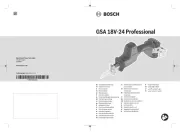
15 September 2025
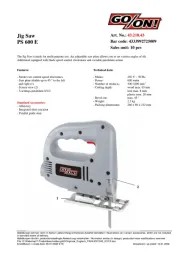
7 September 2025
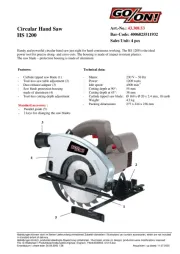
7 September 2025
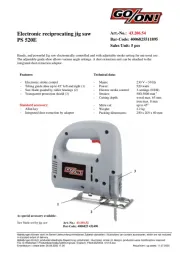
7 September 2025
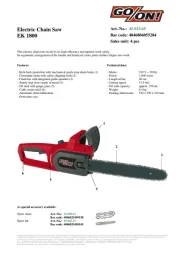
7 September 2025
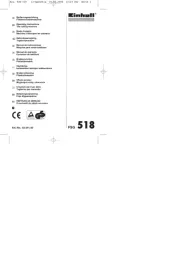
2 September 2025
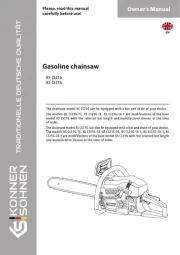
2 September 2025
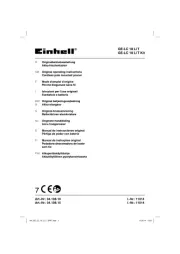
2 September 2025
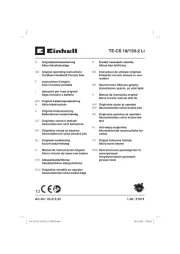
2 September 2025
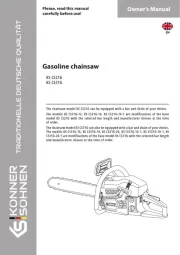
2 September 2025